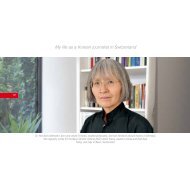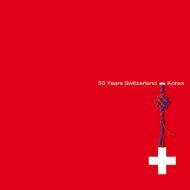The beginnings of Swiss business in Korea - 50 Years Switzerland
The beginnings of Swiss business in Korea - 50 Years Switzerland
The beginnings of Swiss business in Korea - 50 Years Switzerland
Create successful ePaper yourself
Turn your PDF publications into a flip-book with our unique Google optimized e-Paper software.
An overview <strong>of</strong> the economic relations between <strong>Switzerland</strong>and the Republic <strong>of</strong> <strong>Korea</strong><strong>Switzerland</strong> is known to be among the richest countries <strong>in</strong> the world. What is not known is that for most <strong>of</strong> its history,<strong>Switzerland</strong> was actually relatively poor. Even as late as the 19 th century, poverty and lack <strong>of</strong> opportunities drove tens <strong>of</strong>thousands <strong>of</strong> <strong>Swiss</strong> to leave the country to f<strong>in</strong>d their luck <strong>in</strong> otherparts <strong>of</strong> the world.<strong>The</strong> basis for <strong>in</strong>creased wealth was laid <strong>in</strong> the 19 th century by<strong>in</strong>dustrialization. In the 20 th century, <strong>Switzerland</strong> benefited fromthe fact that it was not militarily <strong>in</strong>volved <strong>in</strong> both world wars,was not destroyed and thus had an <strong>in</strong>tact <strong>in</strong>dustrial basis whenpostwar reconstruction began.Trade cont<strong>in</strong>ues to develop and reaches new heights almost every year. In 2011, <strong>Switzerland</strong> exported goods with a totalvalue <strong>of</strong> 2.32 billion <strong>Swiss</strong> francs (2.52 billion US dollars) to <strong>Korea</strong>. <strong>The</strong> ma<strong>in</strong> export items are mach<strong>in</strong>ery (non-electricaland electrical), pharmaceutical products, watches and components, as well as optical and medical devices. <strong>Korea</strong> ma<strong>in</strong>lyexports mach<strong>in</strong>es, automobiles, consumer electronics and chemical products to <strong>Switzerland</strong>. Nowadays, <strong>Korea</strong>n exportsf<strong>in</strong>d their way to <strong>Switzerland</strong> more and more from production facilities <strong>in</strong> Eastern Europe, the Middle East and other Asiancountries.An ever-<strong>in</strong>creas<strong>in</strong>g number <strong>of</strong> <strong>Swiss</strong> companies are establish<strong>in</strong>g <strong>of</strong>fices or production facilities <strong>in</strong> <strong>Korea</strong>. <strong>The</strong> total capitalstock <strong>of</strong> <strong>Swiss</strong> direct <strong>in</strong>vestment <strong>in</strong> <strong>Korea</strong> amounts to several billion US dollars and <strong>Switzerland</strong> ranks among the top 20<strong>in</strong>vestors <strong>in</strong> <strong>Korea</strong>. Unfortunately, <strong>Korea</strong>n companies have not yet found their way to <strong>Switzerland</strong> <strong>in</strong> a significant way. This is<strong>in</strong> stark contrast to <strong>Korea</strong>’s global competitors, which have opened numerous European headquarters <strong>in</strong> <strong>Switzerland</strong>.47<strong>The</strong>re are also more pr<strong>of</strong>ound reasons. From its very beg<strong>in</strong>n<strong>in</strong>gas a nation <strong>in</strong> the 13 th century, <strong>Switzerland</strong> was faced with theproblem <strong>of</strong> hav<strong>in</strong>g no natural resources and it was surroundedby bigger and more powerful neighbors. <strong>The</strong> <strong>Swiss</strong> were forcedto <strong>in</strong>vest <strong>in</strong> the bra<strong>in</strong>s and skills <strong>of</strong> their people and had to f<strong>in</strong>dproducts and services not provided by their competitors. <strong>The</strong>small national market required the <strong>Swiss</strong> from early on to beexport-oriented and to f<strong>in</strong>d markets for their goods <strong>in</strong> Europe andbeyond.<strong>The</strong> <strong>Swiss</strong> National Bank <strong>in</strong> Berne<strong>The</strong> <strong>Swiss</strong> focused on high-quality specialty products <strong>in</strong>agriculture (cheese, milk, chocolate) and later on <strong>in</strong> <strong>in</strong>dustry (watches, precision <strong>in</strong>struments, specialized mach<strong>in</strong>es,textiles, chemicals and pharmaceuticals). <strong>The</strong>y also moved rather early <strong>in</strong>to services and therefore it is no co<strong>in</strong>cidence that<strong>Switzerland</strong> excels <strong>in</strong> various service sectors like bank<strong>in</strong>g, <strong>in</strong>surance, logistics and tourism. This development was greatlysupported by the fact that <strong>Swiss</strong> people master at least two national languages and usually are even more known to carefor decisive details and excel <strong>in</strong> build<strong>in</strong>g long-last<strong>in</strong>g partnerships.<strong>Switzerland</strong>’s economic backbone consists not only <strong>of</strong> its large, mult<strong>in</strong>ational companies, but also to a great extent <strong>of</strong> smalland medium-sized enterprises (SMEs). In fact, <strong>Swiss</strong> SMEs account for 99 percent <strong>of</strong> all companies <strong>in</strong> the country andprovide 67.5 percent <strong>of</strong> all jobs <strong>in</strong> <strong>Switzerland</strong>. <strong>The</strong> whole economy benefits from a well-educated, highly skilled workforceand the latter depend to a large degree on the excellent system <strong>of</strong> vocational tra<strong>in</strong><strong>in</strong>g (see chapter on Education, Scienceand Innovation).S<strong>in</strong>ce the beg<strong>in</strong>n<strong>in</strong>g <strong>of</strong> the 1960s to the present day, <strong>Swiss</strong>-<strong>Korea</strong>n economic relations have been steadily <strong>in</strong>creas<strong>in</strong>g <strong>in</strong>terms <strong>of</strong> volume and <strong>in</strong>volved sectors. This development can be attributed to several factors: globalization, dim<strong>in</strong>ish<strong>in</strong>gtransportation costs, heightened economic <strong>in</strong>terdependence between countries <strong>in</strong> general as well as rules and normsguaranteed by <strong>in</strong>ternational law and <strong>in</strong>stitutions.However, the most important factor was the phenomenal economic development <strong>of</strong> <strong>Korea</strong>. From be<strong>in</strong>g <strong>in</strong> the 1960s one<strong>of</strong> the poorest and least developed countries <strong>in</strong> the world, <strong>Korea</strong> moved successfully higher up the ladder and with<strong>in</strong> thelifetime <strong>of</strong> one generation became a developed economy. This is <strong>in</strong>deed a miracle, the famous “Miracle on the Han River”.In 1995, <strong>Korea</strong> was <strong>in</strong>vited to jo<strong>in</strong> the Organization for Economic Co-operation and Development (OECD). This gave<strong>Switzerland</strong> and <strong>Korea</strong> a common platform to compare policies, seek answers to shared problems, and thus deepen theirrelations. <strong>The</strong> World Trade Organization (WTO) provides another multilateral venue for <strong>Switzerland</strong> and <strong>Korea</strong>. As bothcountries are export-oriented, they are committed to free trade and to strong multilateral frameworks.Over the years, <strong>Korea</strong> and <strong>Switzerland</strong> have established a strong legal framework to support their bilateral economicrelations. By 1971, a mutual <strong>in</strong>vestment and protection agreement was signed. A double taxation agreement followed <strong>in</strong>1980. <strong>The</strong> most important agreement is the Free Trade Agreement (FTA),which <strong>Switzerland</strong> concluded with the Republic <strong>of</strong> <strong>Korea</strong> as part <strong>of</strong> theEFTA (European Free Trade Association; the other members are Iceland,Liechtenste<strong>in</strong> and Norway). <strong>The</strong> FTA was signed <strong>in</strong> 2005 and came <strong>in</strong>to effect<strong>in</strong> September 2006. It was only the third FTA for <strong>Korea</strong> after its agreementswith Chile and S<strong>in</strong>gapore. Based on the experiences with these smallerpartners, <strong>Korea</strong> has moved on to conclude FTAs with bigger partners, such asthe ASEAN, EU and the United States.With very few exceptions, all large <strong>Swiss</strong> companies have established apresence <strong>in</strong> <strong>Korea</strong>. However, the SMEs are not yet as well represented. Giventhe opportunities for SMEs <strong>in</strong> <strong>Korea</strong>, it was decided to open a <strong>Swiss</strong> Bus<strong>in</strong>essHub (part <strong>of</strong> OSEC, the <strong>Swiss</strong> equivalent <strong>of</strong> <strong>Korea</strong>’s KOTRA) at the <strong>Swiss</strong>Embassy <strong>in</strong> Seoul <strong>in</strong> November 2010. OSEC and KOTRA have also re<strong>in</strong>forcedtheir exchanges and cooperation, thus add<strong>in</strong>g valuable support to thecompanies <strong>in</strong> both countries and stimulat<strong>in</strong>g bilateral trade and <strong>in</strong>vestment.Exchange and network<strong>in</strong>g are also supported by the <strong>Swiss</strong>-<strong>Korea</strong>n Bus<strong>in</strong>essCouncil (SKBC) <strong>in</strong> <strong>Korea</strong>, <strong>in</strong> which almost all <strong>Swiss</strong> companies participate asmembers. <strong>The</strong> council organizes monthly <strong>bus<strong>in</strong>ess</strong> luncheons, talks as well asother events and constitutes an important and useful platform for the privatesector.<strong>The</strong> <strong>Swiss</strong> Embassy, the <strong>Swiss</strong> Bus<strong>in</strong>ess Hub and SKBC closely co-operate with <strong>Korea</strong>n associations and other <strong>bus<strong>in</strong>ess</strong>chambers (most notably with the <strong>Korea</strong>n-German Chamber <strong>of</strong> Commerce and the European Union Chamber <strong>of</strong> Commerce<strong>in</strong> <strong>Korea</strong>). Although the <strong>Swiss</strong> <strong>bus<strong>in</strong>ess</strong> community <strong>in</strong> <strong>Korea</strong> is rather small, it is well connected and can benefit fromsynergies with many partners.In its economic development, <strong>Korea</strong> is mov<strong>in</strong>g from <strong>in</strong>dustrial optimization to <strong>in</strong>novation and from the <strong>in</strong>dustrial to theservice sector. As <strong>Switzerland</strong> is a successful example <strong>of</strong> these transformations, the potential for further exchange andcooperation is substantial. Equally, <strong>in</strong> trade, <strong>in</strong>vestment and <strong>in</strong>dustrial R&D the potential is far from exploited. <strong>The</strong> door forfurther expansion <strong>of</strong> the bilateral economic relations <strong>in</strong> the com<strong>in</strong>g <strong>50</strong> years is wide open and the opportunities should begrasped <strong>in</strong> both countries.48






